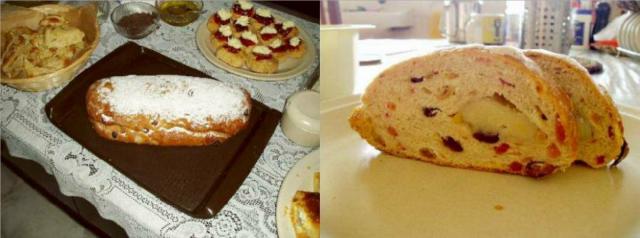Hello all,
Maybe the forum is a better place for this, but I wanted to introduce myself and ramble a bit. I am a new sourdough baker (and currently have no interest in yeast breads) with about 10 loaves under my belt. In addition to being a lover of sourdough, I am also a stay-at-home dad with a 4 month old daughter, an avid cook, home-brewer, urban gardener, beekeeper, and chicken-raiser and love cycling, hiking and backpacking. Also, I love to learn and tend to throw myself into new hobbies.
I got into baking after reading Classic Sourdoughs by Ed Wood and aquiring a culture (his Finland culture). After a few bakes, with few real successes (dense crumbs, the second half of the loaves mostly went to the chickens), I discovered The Fresh Loaf and my education really began. Firstly, thank you to this community of passionate bakers with a willingness to share. I think my initial lack of success was due to poor kneading technique, over-proofing and perhaps using mostly all-purpose flour. My last few loaves have been quite successful and I think (based on a slightly educated guess) it's related to limiting my bulk fermentation to about 6 hrs, incorporating about 50% bread flour and improving gluten development in the dough via autolysing and doing several stretcch and folds during fermentation. Needless-to-say, I'm eager to broaden my experience and continue developing my techniques. As I'm still a beginning baker I realize I have MUCH to learn and am hoping for a few suggestions.
First of all, I'd love to know what experienced bakers would suggest regarding equipment. So far, I have only the very, very basics: some measuring cups, large pyrex mixing bowls, some counter space or large wooden cutting boards, and a couple of baking sheets. I'm the type that likes to keep things simple and have neither the space or funds for significant equipment (aka a mixer), but I wonder if a few basic things like a dough whisk, dough cutter/scraper and scale would be my best initial investments? It definitely seems to me that a scale is necessary to truly get consistent results and be able to precisely control hydration (not to mention it seems experienced bakers here only list their recipes by weight). What are your favorite or indispensible tools?
My second question regards techniques. I started following Ed Wood's advice (all-purpose flour, not preheating oven, I even put together a proofing box to control temperature - I've barely used it). I realize now that the suggestions he provides in Classic Sourdoughs: A Home Baker's Handbook, are neither typical nor particularly extensive. He seems to imply that temperature is the primary driver of sourdough flavor, higher temperature favoring bacteria and sourness, potentially at the expense of leaving ability. However, from some of my subsequent reading on TFL and elsewhere, it seems the picture is much more complicated and that the sourness of sourdough is multifaceted (lactic and acetic), and can be influenced by the hydration of the starter (cooler and drier favors the yeast?), temperature, length of different proofs, even how long after the baked bread cools that it is sliced (so the flavor continues to mature even after baking?). Many questions, I know. Regardless, as I embraced the broader world of sourdough baking suggestions I seem to have had more success, though I don't yet have enough experience to fully understand why. So what technique or change in process first propelled your sourdough to the next level? Also, there seem to be many valuable books that could enhance my understanding and baking, what would you recommend?
In regards to my loaves, I'm still perfecting my basic loaf: a 1.5-2lb white (or mostly white) sourdough batard. Here's my basic process, I'm willing to tweak it and am open to criticism and suggestions. My current process involves thoroughly mixing by hand, letting autolyse for 30 minutes to an hour, adding the salt and the last cup of flour, a short maybe 10 minute kneading (I'm still not very good), then rest in a covered bowl and do a stretch and fold about once an hour for 4 hrs allowing a total of 5-6 hrs bulk ferment, then removing from bowl, letting rest for 30 minutes, shaping (which I still need practice at), allowing to ferment (covered) an additional 3 hrs, brushing crust with melted butter, slashing, placing in a 450 - 475F preheated oven, spritzing oven with a spray bottle 3 times at 5 minute intervals in the first 10 minutes, turning loaf once, removing from the oven after about 40 minutes and allowing to cool overnight on a wire rack. The result is a pretty decent loaf: crispy-chewy golden brown crust with some blistering, moderately open and moist crumb, not particularly complex or sour but delicious. I'm pretty happy with the result (its as good as anything I can buy locally), but would ultimately like to be able to increase the sourness, get a more complex overall flavor, get a consistently attractive bubbled/blistered golden brown crust, reliably achieve a more open crumb, and hit the shape I'm going for (my last 3 "good" loaves were all rather wet doughs and despite my shaping attempts were slightly flattened, maybe 2-1/2" high).
Sorry for the lengthy post. Thanks again to the entire TFL community for sharing your skills and wisdom, particularly the imformative posts of dmsnyder and txfarmer (and many others I have yet to discover). I look forward to hearing from anyone willing to give me guidance on where to go from here!
Cheers,
Kirk
P.S. - Equipment-wise a scale is probably on top of the list, then I'll try my hand at some of the amazing recipes on TFL like dmsnyder's San Joaquin Sourdough or txfarmer's 36+ hr Baguettes




